Pensamiento indígena y medio ambiente en la jurisprudencia de las altas cortes de Colombia
DOI:
https://doi.org/10.22267/rceilat.214849.97Palabras clave:
Pensamiento indígena, Medio ambiente, Territorio, Altas cortes, ConstitucionalismoResumen
El constitucionalismo latinoamericano de los años 90, caracterizado por su manifestación utópica, permitió el reconocimiento de los derechos de los pueblos indígenas históricamente invisibilizados, además del reconocimiento de la ciudadanía y la garantía de la protección cultural, lingüística, jurídica y territorial.
Este último punto debe ser entendido más allá de una mirada política – jurisprudencial, ya que los resguardos indígenas incluyen, además de áreas delimitadas de vivienda, producción económica y extracción de recursos, una relación humana con el paisaje y el entorno. Por ello las Altas Cortes colombianas han explicado el vínculo entre las comunidades y la preservación de sus territorios desde la espiritualidad, la cosmovisión, la supervivencia y el aprovechamiento y protección del medio ambiente.
Descargas
Citas
Aguilar, G. (Octubre de 2003). Proyecto Regional de Manejo Integrado de Ecosistemas por Pueblo Indígenas y Comunidades de Centroamérica. Conocimiento Tradicional sobre la Biodiversidad en el Proyecto Manejo Integrado de Ecosistemas por Pueblo Indígenas y Comunidades. GEF-PPG-No. 051362.
Antezana, L. H. (Septiembre de 2009). Biblioteca CLACSO. Obtenido de http://biblioteca.clacso.edu.ar/clacso/coediciones/20160315033915/07antezana.pdf
CEPAL . (2014). Conferencia Mundial de los Pueblos Indígenas. Los Pueblos Indígenas en América Latina (pág. 26). Santiago de Chile: Limitada .
Descola, P. (2004). Las cosmologías indígenas de la Amazonía . En A. S. Hierro, TIERRA ADENTRO: territorio indígena y percepción del entorno (págs. 25-35). Copenhague: IWGIA .
Echeverri, J. Á. (2004). Territorio como cuerpo y territorio como naturaleza: ¿Diálogo intercultural? En A. S. Henao, Tierra adentro: territorio indígena y percepción del entorno (págs. 259 - 275). Copenhage : IWGIA .
Ensabella, B. (2016 ). Derechos de la naturaleza. Ética biocéntrica y políticas ambientales. Revista Latinoamericana , 638-688.
Foucault, M. (1990). Tecnologías del yo y otros textos afines . Barcelona : Paidós Ibérica S.A. .
Gómez-Rivera, M. (Julio de 2014). Red de biblioteca CLACSO. Obtenido de http://biblioteca.clacso.edu.ar/Mexico/cieap-uaem/20170424052329/pdf_495.pdf
Hierro, P. G. (2004). Territorios Indígenas: tocando a las puertas del derecho . En A. S. Hierro, TIERRA ADENTRO: territorio indígena y percepción del entorno (pág. 278). Copenhague: IWGIA .
Lévi-Strauss, C. (1962). PENSAMIENTO SALVAJE . París: FONDO DE CULTURA ECONÓMICA.
Rappaport, J. (2004). La geografía y la concepción de la historia de los Nasa. En A. S. Hierro, TIERRA ADENTRO territorio indígena y percepción del entorno (pág. 174). Copenhague: IWGIA.
Sentencia C - 431 (Corte Constitucional 2000).
Sentencia SU - 123 (Corte Constitucional 2018).
Sentencia T - 052 (Corte Constitucional 2017).
Sentencia T - 380 (Corte Constitucional 1993).
Sentencia T - 622 (Corte Constitucional 2016).
Sentencia T - 634 (Corte Constitucional 1999).
Sentencia T - 693 (Corte Constitucional 2011).
Sentencia T - 849 (Corte Constitucional 2014).
Publicado
Cómo citar
Número
Sección
Licencia
Derechos de autor 2021 Estudios Latinoamericanos

Esta obra está bajo una licencia internacional Creative Commons Atribución-NoComercial-SinDerivadas 4.0.
Otras métricas:











_(2).png)








